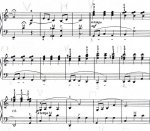Happy girl
Well-known member
- Joined
- Oct 31, 2013
- Messages
- 319
- Reaction score
- 24
This exercise is from the Palmer Hughes Recital Book 3 - page 14- JUST A SONG AT TWILIGHT
What I seem unable to master, (& I have been practising & going back to it for weeks now) is the treble chord sequence. Subsequent treble sequences in the book create no challenge so it is puzzling to me where the blockage is. I recognise that my reading capacity is not up to playing at speed. but I can’t even manage a coherent effort as I need to read every note.
I can usually find a logical sequence to a new piece which helps enormously, but I somehow can’t fathom this.
With which method would a teacher ask a student to practice an exercise which, in essence, appears to be too difficult for the student, but is in fact part of a structured piece of learning which theoretically should be achievable without too much huffing &
puffing?
I did hesitate to submit this post; I suspect the answer is practice, practice & more practice, but without guidance & advice, the danger could be to keep practicing the same routine of mistakes
What I seem unable to master, (& I have been practising & going back to it for weeks now) is the treble chord sequence. Subsequent treble sequences in the book create no challenge so it is puzzling to me where the blockage is. I recognise that my reading capacity is not up to playing at speed. but I can’t even manage a coherent effort as I need to read every note.
I can usually find a logical sequence to a new piece which helps enormously, but I somehow can’t fathom this.
With which method would a teacher ask a student to practice an exercise which, in essence, appears to be too difficult for the student, but is in fact part of a structured piece of learning which theoretically should be achievable without too much huffing &
puffing?
I did hesitate to submit this post; I suspect the answer is practice, practice & more practice, but without guidance & advice, the danger could be to keep practicing the same routine of mistakes

